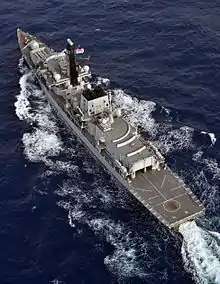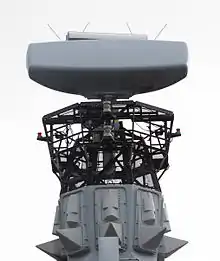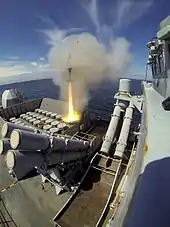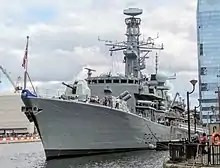Type 23 frigate
The Type 23 frigate or Duke class is a class of frigates built for the United Kingdom's Royal Navy. The ships are named after British Dukes, thus leading to the class being commonly known as the Duke class. The first Type 23, HMS Norfolk, was commissioned in 1989, and the sixteenth, HMS St Albans was commissioned in June 2002. They form the core of the Royal Navy's destroyer and frigate fleet and serve alongside the Type 45 destroyers. Originally designed for anti-submarine warfare in the North Atlantic, the Royal Navy's Type 23 frigates have proven their versatility in warfighting, peacekeeping and maritime security operations around the globe.[2] Thirteen Type 23 frigates remain in service with the Royal Navy, with three vessels having been sold to the Chilean Navy.
_MoD.jpg.webp) HMS Sutherland (F81), December 2012 | |
| Class overview | |
|---|---|
| Name: | Type 23 frigate |
| Builders: | Yarrow Shipbuilders and Swan Hunter |
| Operators: | |
| Preceded by: | Type 22 frigate |
| Succeeded by: | |
| Cost: | £130 million (US$167 million) per ship |
| In commission: | 24 November 1987 |
| Planned: | 16 |
| Completed: | 16 |
| Active: | 13 Royal Navy, 3 Chilean Navy |
| General characteristics | |
| Type: | Anti-submarine warfare frigate |
| Displacement: | 4,900 t (4,800 long tons; 5,400 short tons)[1] |
| Length: | 133.0 m (436 ft 4 in) |
| Beam: | 16.1 m (52 ft 10 in) |
| Draught: | 7.3 m (23 ft 11 in) |
| Propulsion: |
|
| Speed: | In excess of 28 knots (52 km/h; 32 mph) (HMS Sutherland achieved 34.4 knots (63.7 km/h; 39.6 mph) during high-speed trials in November 2008) |
| Range: | 7,500 nmi (14,000 km) at 15 kn (28 km/h) |
| Boats & landing craft carried: | 2 × Pacific 24 RIBs |
| Complement: | 185 (accommodation for up to 205) |
| Electronic warfare & decoys: |
|
| Armament: |
|
| Aircraft carried: |
|
| Aviation facilities: |
|
The Royal Navy's current Type 23 frigates will be replaced by the Type 26 Global Combat Ship starting from 2023, and later the Type 31 frigate.[3] As of 2012 it is planned that HMS St Albans will be the last to retire from the Royal Navy, in 2036.[4][5]
Development
When first conceived in the late 1970s, the Type 23 was intended to be a light anti-submarine frigate to counter Soviet nuclear submarines operating in the North Atlantic. The Type 23 would be replacing the Leander-class frigates (which had entered service in the 1960s) and the Type 21 frigate (a general purpose design that had recently entered service) as "the backbone of the Royal Navy's surface ship anti-submarine force". Although not intended to replace the Type 22 frigate, reductions in the size of the Navy due to the 1998 Strategic Defence Review led to HMS St Albans replacing HMS Coventry, a Type 22 frigate.[6]

The ships were intended to carry a towed array sonar to detect Soviet submarines in the North Atlantic and carry a Westland Lynx or EHI Merlin helicopter to attack them.[7] It was initially proposed that the frigates would not mount defensive armament. Instead the Sea Wolf missile system was to be carried by Fort Victoria-class replenishment oilers, one of which was to support typically four Type 23s. The Fort-class oilers would also provide servicing facilities for the force's helicopters; the Type 23 would have facilities only for rearming and refuelling them.
As a result of lessons learned from the Falklands War, the design grew in size and complexity to encompass the Vertical Launch (VLS) Sea Wolf system with an extra tracking system as a defence against low-flying aircraft and sea-skimming anti-ship missiles such as Exocet.[7] With the addition of Harpoon surface-to-surface missiles and a medium calibre gun for naval gunfire support, the Type 23 had evolved into a more complex and balanced vessel optimised for general warfare, which introduced a host of new technologies and concepts to the Royal Navy. These included extensive radar cross-section reduction design measures, automation to substantially reduce crew size, a combined diesel-electric and gas (CODLAG) propulsion system providing very quiet running for anti-submarine operations along with excellent range, vertical launch missile technology and a fully distributed combat management system.
The Vertical Launch Sea Wolf surface-to-air missile system was designed for and first deployed on the Type 23. Unlike conventional Sea Wolf, the missile is boosted vertically until it clears the ship's superstructure, and then turns to fly directly to the target. Consequently, the ship's structure does not impose no-fire directions that would delay or inhibit missile firing in a conventionally launched system.
Although the Type 23 is officially the "Duke" class, and includes such famous names as HMS Iron Duke (which had been the name of the battleship HMS Iron Duke, Admiral Jellicoe's flagship at the Battle of Jutland), five of the names had previously been used on classes known as the "County class": Kent and Norfolk were names given both to 1960s guided missile destroyers and Second World War-era County-class heavy cruisers, while Monmouth, Lancaster, Kent and Argyll revived names carried by First World War-era Monmouth-class armoured cruisers. This use of Ducal and County names broke a tradition of alphabetical names for escort ships which had run in two – not unbroken – cycles from the L-class destroyers of 1913 to the Daring-class destroyers of 1950; this progression was revived with the Amazon-class Type 21 frigates of 1972–1975, and continued with B and C names for most of the Type 22 frigates of 1976–1989. However, the D names have since been used for the new Type 45 Daring-class destroyers, the first of which entered service in 2009.
It was reported in 1998 to the House of Commons that: "Type 23 frigates achieved approximately 85–89 per cent average availability for operational service in each of the last five years with the exception of 1996 when the figure dropped to just over 80 per cent due to a number of ships experiencing a particular defect. This discounts time spent in planned maintenance."[8]
Unlike the Type 45 destroyer, the "Type 23 frigate does not have the capability or configuration to act as flagship and is not tasked in this way."[9]
Programme costs
Prior to the Falklands War the cost of the Type 23 frigates was estimated at £75 million each (September 1980 prices)[10] Changes following the experiences in the Falklands, including improved damage control and fire precautions,[11] led to an increased cost estimated at £110 million (1984–85 prices)[10] By 2001, the Ministry of Defence said the cost of HMS Norfolk was £135.449 million and the remaining ships would have a final cost between £60 million and £96 million each. The Ministry of Defence said in 1998 that the Merlin ASW helicopter was costing them £97M each (this was for an order for 44 airframes), and that this was 57% of the cost of Type 23.[12] From this it can be calculated that the cost of Type 23 was £170.1M each. The Government's declared policy for construction contracts for Type 23 was "...competition, the aim being to secure best value for money for the defence budget." while maintaining "sufficient warship-building capacity to meet likely future defence requirements and a competitive base"[13]
HMS Norfolk was the first of the class to enter service, commissioned into the Fleet on 1 June 1990 at a cost of £135.449 million GBP, later vessels cost £60–96 million GBP.[14]
Upgrades and future technologies


Mid-life refit
The class underwent mid-life refits which lasted 12–18 months and cost £15-20m. Aside from refurbishment of the mess decks and drive train, the ships are being fitted with a transom flap which can add up to one knot (1.9 km/h; 1.2 mph) to the top speed[15] and reduce fuel consumption by 13%, and Intersleek anti-fouling paint which added two knots (3.7 km/h; 2.3 mph) to the top speed of Ark Royal.[16] Although the top speed of the Duke class is commonly quoted as 28 knots, the caption of an official Navy photo suggests that Lancaster was capable of 32 knots even before her mid-life refit.[17][18] The Sea Wolf Mid Life Update (SWMLU) improves the sensors and guidance of the missiles, point defences are further improved with new remotely operated 30 mm guns, and Mod 1 of the Mk8 main gun has an all-electric loading system and a smaller radar cross-section. The communications and command systems are also upgraded.
A further refit is expected, with HMS Argyll being the first to receive this Life Extension (LIFEX) Upkeep. Amongst the upgrades will be the replacement of the Sea Wolf missiles with the new Sea Ceptor anti-air defence missiles;[19] these were first test-fired from HMS Argyll on 4 September 2017.[20]
Sonar 2087
Sonar 2087 is described by its manufacturer as "a towed-array system that enables Type 23 frigates to hunt the latest submarines at considerable distances and locate them beyond the range at which they [submarines] can launch an attack."[21] Sonar 2087 was fitted to eight Type 23 frigates in mid-life refits between 2004 and 2012; the five oldest Type 23 frigates, HMS Montrose, Monmouth, Iron Duke, Lancaster and Argyll are not scheduled to receive Sonar 2087. These ships will instead continue to be employed across the normal range of standing Royal Navy deployments. The Chilean Navy is procuring a number of Sonar 2087 towed arrays from Thales Underwater Systems to equip its multipurpose frigates.[22]
Artisan 3D radar
The Type 23's medium-range radar will be replaced by BAE Systems Insyte Type 997 Artisan 3D radar. It is a medium-range radar designed to be extremely modular and highly configurable to provide a cost-effective high-performance radar, capable of operating effectively in littoral zones and improving air-defence, anti-surface (anti-ship) and air traffic management capabilities of the Type 23 frigates. Protection measures are also added to maintain detection ranges even when attacked by complex jammers.[23][24] HMS Iron Duke is the first Type 23 frigate to have received the Type 997 Artisan 3D radar during her refit in 2012–13.[25] It will be fitted to all T23's as well as the assault platforms (LPD) – HMS Albion and HMS Bulwark, the Helicopter Platform (LPH) – HMS Ocean and the two Queen Elizabeth-class aircraft carriers are also planned to be equipped with the same radar. The project was worth £100 million and the contract was announced on 4 August 2008.[26]
HMS Iron Duke received her new Type 997 Artisan 3D radar in 2013. It is claimed the radar is five times more capable than the Type 996 radar it replaces.[27][28]
Common Anti-Air Modular Missile
CAMM(M), the maritime variant of the Common Anti-Air Modular Missile, is intended to replace the Sea Wolf missiles on the Type 23 frigates starting from 2016. CAMM(M) has a longer range of 1–25+ km compared to the 1–10 km offered by the Sea Wolf missile. An option exists to give the missile a surface-attack capability, though it is currently understood the Royal Navy will not take that option, because of cost.[29] Like Sea Wolf, CAMM(M) will be VLS launched; however due to its design, CAMM(M) can be packed much more tightly into the VLS, with up to four CAMM(M) fitting into the space occupied by one Sea Wolf missile.[30] CAMM(M) is known as Sea Ceptor in Royal Navy service.
Martlet Lightweight Multirole Missile
On an unspecified date in early 2019, HMS Sutherland tested a modified mounting for the 30mm cannon which incorporated a launcher for five 'Martlet' Lightweight Multirole Missiles, by firing four of them at a small speedboat target at the Aberporth range in Wales. The concept of mounting the missile alongside the 30mm Bushmaster cannon was tested just 5 months after the idea's conception.
The intended role of the Martlet is to further extend the Type 23's capabilities against small, fast moving targets beyond the current 30mm, GPMG and Minigun options to provide a long range 'stand-off' ability. It is not yet clear whether the Royal Navy intends to equip any more Type 23s with the system.[31]
Weapons, countermeasures, capabilities and sensors

_launches_an_AGM-84A_%22Harpoon%22_missile.jpg.webp)

- Anti-air warfare
- A BAE Systems Type 996 Mod 1, 3D surveillance and target indication radar.
- Two Marconi Electronic Systems Type 911 fire control radars.
A 32-cell Sea Wolf GWS.26 VLS canisters for up to 32:
- Sea Wolf missiles (range 1–10 km)
The Type 996 Mod 1, 3D surveillance and target indication radar is being replaced on all Type 23 frigates by the more capable Type 997 Artisan 3D radar.
All frigates are being upgraded with the Sea Ceptor SAM system (range of up to 25 km) as replacement for Sea Wolf. HMS Argyll was the first ship to receive Sea Ceptor, completing refit in February 2017.[32]As of 2021 in addition to Argyll, Westminster, Montrose, Northumberland, Kent, Lancaster, and Richmond have all received Sea Ceptor systems. Portland and Somerset are scheduled to receive Sea Ceptor during 2021.[33]
- Anti-ship warfare
- 2× 4 Harpoon anti-ship missile launchers for a total of 8 Harpoon anti-ship missiles.
- 1× BAE Systems 4.5 inch Mark 8 naval gun has an anti-ship role.
- Up to one embarked Agusta Westland AW159 Wildcat helicopter is to be equipped with Martlet anti-ship missiles (IOC 2021) or Sea Venom anti-ship missiles (IOC 2022).
- Anti-submarine warfare
- A Thales Underwater Systems Type 2050 bow sonar scheduled to be replaced by an Ultra Electronics Type 2150 next generation ASW bow sonar in due course.
- An Ultra Electronics Type 2031Z towed sonar on five of the Type 23 frigates – no longer in RN service.
- A Type 2087 towed sonar on eight of the Type 23 frigates.
- 2× twin 12.75 in (324 mm) magazine launched torpedo tubes built by SEA Ltd for anti-submarine Sting Ray torpedoes. The tubes are magazine reloaded.
- Up to one embarked Agusta Westland AW159 Wildcat or one AgustaWestland EH101 Merlin helicopter can be equipped with 2-4× anti-submarine Sting Ray torpedoes respectively. An embarked Merlin HM2 helicopter is equipped with its own dipping sonar, sonobuoys and radars; For submarine targets, Wildcat relies on the ship's sensors.[34]
- Land-attack
- The 1× BAE Systems 4.5 inch Mark 8 naval gun has a naval gunfire support (NGS) role.
- Guns
- 1× BAE Systems 4.5 inch Mark 8 naval gun.
- 2× 30mm DS30M Mark 2 Automated Small Calibre Guns or 30mm DS30B guns.
- 2× Miniguns.
- 4× General-purpose machine guns.
- Countermeasures
- The Seagnat decoy system allows for the seduction and distraction of radar guided weapons, through active and passive means.
- Type 182 towed torpedo decoys.
- Type 2070 towed torpedo decoy system.
- Thales defence Scorpion Electronic Counter Measures/UAF-1 ESM Jammer. Used to confuse or block enemy radar making the Type 23 frigate harder to detect and or locked onto by enemy radar/sonar guided weapons.
- Electronic systems
- Navigation: Kelvin Hughes Radar Type 1007 and Racal Decca Type 1008.
- fire-control system: Sperry Sea Archer 30 optronic surveillance/director'
- Combat Management System: BAE Systems Command System DNA(2)'[35]
- Additional capabilities
- The Type 23 frigates have sufficient space to embark a small detachment of Royal Marines and their equipment.
Ships

On 21 July 2004, in the Delivering Security in a Changing World review of defence spending, Defence Secretary Geoff Hoon announced that Norfolk, Marlborough and Grafton were to be paid off. In 2005 it was announced that these three vessels would be sold to the Chilean Navy, to be delivered in 2008. In September 2005 BAE Systems was awarded a £134 million GBP contract to prepare the frigates for transfer. ex-Marlborough, ex-Norfolk and ex-Grafton were sold to Chile for a total of £134 million. The letter of intent for purchase was signed in December 2004, followed by a formal contract on 7 September 2005.[36] ex-Norfolk was handed over by the Defence Logistics Organisation and BAE Systems and commissioned into the Chilean Navy on 22 November 2006, and named Almirante Cochrane (FF-05) (after Lord Cochrane, a naval hero to both the British and Chileans). Ex-Grafton was delivered to Chilean Navy on 28 March 2007 at Portsmouth and renamed Almirante Lynch (FF-07). Ex-Marlborough was delivered to Chilean Navy on 28 May 2008 at Portsmouth and renamed Almirante Condell (FF-06).
The five oldest ships in Royal Navy service are classified as General Purpose ships, and are primarily homeported at Portsmouth. The remainder are equipped with the Type 2087 Towed Array Sonar, and are primarily tasked with the anti-submarine warfare mission. These eight ships are based primarily at Devonport.[37] The remaining Type 23 ships in the Royal Navy are due to be replaced in service by the Type 26 ASW and Type 31 general purpose frigates.[38] The oldest remaining Type 23, HMS Argyll, is due to be decommissioned in 2023, with approximately one ship per year decommissioned after that.[39]
| Name | Pennant No. | Type | Builder | Laid down | Launched | Commissioned | Status |
|---|---|---|---|---|---|---|---|
| Norfolk | F230 | Marconi Marine (YSL), Scotstoun | 14 December 1985[40] | 10 July 1987[40] | 1 June 1990[40] | To Chile as Almirante Cochrane | |
| Marlborough | F233 | Swan Hunter, Wallsend | 22 October 1987[40] | 21 January 1989[40] | 14 June 1991[40] | To Chile as Almirante Condell | |
| Argyll | F231 | GP | Marconi Marine (YSL), Scotstoun | 20 March 1987[40] | 8 April 1989[40] | 31 May 1991[40] | In active service[39] |
| Lancaster | F229 | GP | Marconi Marine (YSL), Scotstoun | 18 December 1987[40] | 24 May 1990[40] | 1 May 1992[41] | In active service[39] |
| Iron Duke | F234 | GP | Marconi Marine (YSL), Scotstoun | 12 December 1988[40] | 2 March 1991[40] | 20 May 1993[40] | In active service[39] |
| Monmouth | F235 | GP | Marconi Marine (YSL), Scotstoun | 1 June 1989[40] | 23 November 1991[40] | 24 September 1993[40] | In active service[39] |
| Montrose | F236 | GP | Marconi Marine (YSL), Scotstoun | 1 November 1989[40] | 31 July 1992[40] | 2 June 1994[41] | In active service[39] |
| Westminster | F237 | ASW | Swan Hunter, Wallsend | 18 January 1991[40] | 4 February 1992[41] | 13 May 1994[40] | In active service[39] |
| Northumberland | F238 | ASW | Swan Hunter, Wallsend | 4 April 1991[40] | 4 April 1992[40] | 29 November 1994[41] | In active service[39] |
| Richmond | F239 | ASW | Swan Hunter, Wallsend | 16 February 1992[41] | 6 April 1993[40] | 22 June 1995[41] | In active service[39] |
| Somerset | F82 | ASW | Marconi Marine (YSL), Scotstoun | 12 October 1992[40] | 25 June 1994[40] | 20 September 1996[41] | In active service[39] |
| Grafton | F80 | Marconi Marine (YSL), Scotstoun | 13 May 1993[40] | 5 November 1994[40] | 29 May 1997[40] | To Chile as Almirante Lynch | |
| Sutherland | F81 | ASW | Marconi Marine (YSL), Scotstoun | 14 October 1993[40] | 9 March 1996[40] | 4 July 1997[41] | In active service[39] |
| Kent | F78 | ASW | Marconi Marine (YSL), Scotstoun | 16 April 1997[41] | 27 May 1998[41] | 8 June 2000[41] | In active service[39] |
| Portland | F79 | ASW | Marconi Marine (YSL), Scotstoun | 14 January 1998[41] | 15 May 1999[41] | 3 May 2001[41] | In active service[39] |
| St Albans | F83 | ASW | Marconi Marine (YSL), Scotstoun | 18 April 1999[41] | 6 May 2000[41] | 6 June 2002[41] | In active service[39] |
| Almirante Cochrane | FF05 | ASW | Marconi Marine (YSL), Scotstoun | 14 December 1985[40] | 10 July 1987[40] | 22 November 2006 | In active service |
| Almirante Condell | FF06 | ASW | Swan Hunter, Wallsend | 22 October 1987[40] | 21 January 1989[40] | 28 May 2008 | In active service |
| Almirante Lynch | FF07 | ASW | Marconi Marine (YSL), Scotstoun | 13 May 1993[40] | 5 November 1994[40] | 28 March 2007 | In active service |
In fiction
- HMS Westminster was used for the Type 23 interior shots in the James Bond film Tomorrow Never Dies in three different roles as HMS Chester, HMS Devonshire and HMS Bedford. For the exterior shots a Type 23 model was constructed.
- The ITV series Making Waves was set aboard the Type 23 frigate HMS Suffolk (which was portrayed by HMS Grafton).
- HMS Montrose and HMS Monmouth were used to portray the interior and exterior shots of the fictional HMS Monarch for the film Command Approved[42] which is the centre piece of Action Stations at Portsmouth Historic Dockyard, Portsmouth, England.
- The fictional HMS Beaufort is the centrepiece of British author Mike Lunnon-Wood's novel King's Shilling. In it, HMS Beaufort is tasked to evacuate the British embassy and citizens in the Liberian capital Monrovia during the 1990s civil war.
- The TNT series The Last Ship featured a Chilean Duke-class frigate in the fourth episode of its fifth season, charging an Arleigh Burke-class destroyer and landing a hit with one of four Sea Wolf missiles.
References
- "Type 23 Frigate". Royal Navy. Retrieved 25 March 2019.
- "Mission Systems provides the Royal Navy's Type 23 Frigates with combat management systems and radar". BAE Systems. Archived from the original on 7 January 2012. Retrieved 25 March 2019.
- "Royal Navy Future Ships: Type 26 Global Combat Ship". Royal Navy. Retrieved 25 March 2019.
- Andrew Robathan, Minister of State for the Armed Forces (6 September 2012). "Written Answers to Questions: HMS Argyll". Parliamentary Debates (Hansard). House of Commons. col. 386W.
- "Navy unveils latest design of future frigate". Royal Navy. 20 August 2012. Archived from the original on 14 October 2012. Retrieved 25 March 2019.
- John Spellar, Minister of State for the Armed Forces (11 July 2000). "Airborne Early Warning Capability". Parliamentary Debates (Hansard). House of Commons. col. 449W.
Question to the Secretary of State for Defence when he planned to withdraw the Type 22 Batch II frigates from service. His answer was:
HMS Sheffield 2012 – to be superseded by a T45 Destroyer
HMS Coventry 2001 – to be superseded by HMS St. Albans, a T23 Frigate. - "Defence; Where's the cache?". The Economist. 10 July 1982. p. 21.
- John Reid, Minister of State for the Armed Forces (10 February 1998). "Type 23 Frigates". Parliamentary Debates (Hansard). House of Commons. col. 195–196.
- Peter Luff, Minister for Defence Procurement (17 March 2011). "Frigates". Parliamentary Debates (Hansard). House of Commons. col. 511W.
- John Lee, Parliamentary Under-Secretary of State to the Minister for Defence Procurement (11 January 1985). "Written Answers: Type 23 Frigates". Parliamentary Debates (Hansard). House of Commons. col. 561W.
- Ian Stewart, Minister of State for the Armed Forces (19 July 1983). "Defence Estimates". Parliamentary Debates (Hansard). House of Commons. col. 261.
- "At Hebburn". Warship World. Maritime Books. 18 February 1998. p. 13.
This figure of £97 million each included research and development costs.
- Michael Neubert, Under-Secretary of State for the Armed Forces (2 November 1989). "Written Answers: Frigates". Parliamentary Debates (Hansard). House of Commons. col. 334W.
- Adam Ingram, Minister of State for the Armed Forces (5 July 2001). "Written Answers: Type 23 Frigates". Parliamentary Debates (Hansard). House of Commons. col. 246W.
- "A Forth for Good". Navy News. September 2008. p. 6.
- "The Royal Navy's Fleet" (PDF). Royal Navy Matters. Royal Navy. 2010. p. 52. Retrieved 16 October 2011.
- "Duke class Type 23 Frigate F229 HMS Lancaster steaming at 32 knots". Ministry of Defence Image Database. 12 September 1999. Retrieved 25 March 2019.
- "HMS Sutherland – More About The Ship". Royal Navy. Retrieved 16 October 2011.
- "HMS Argyll upkeep marks start of Type 23 life extension". ADS Advance. 16 June 2015. Retrieved 3 August 2016.
- "New missiles tested off Scottish coast". BBC News. 4 September 2017. Retrieved 4 September 2017.
- Thales Group (13 July 2010). "HMS Sutherland's Sonar Impresses on First Major Test". Globalsecurity.org. Retrieved 25 March 2019.
- "Written Answers: Type 23 Frigates (Sonar 2087)". TheyWorkForYou. 17 July 2006. Retrieved 3 August 2016.
- "Artisan 3D Radar". BAE Systems. Archived from the original on 11 December 2011. Retrieved 3 August 2016.
- "Artisan 3D Radar". BAE Systems. Archived from the original on 8 March 2011. Retrieved 3 August 2016.
- "New Royal Navy Type 997 radar is put through its paces on the Isle of Wight". BAE Systems. 13 September 2011. Archived from the original on 1 November 2011. Retrieved 16 October 2011.
- "Navy to Get New Radar". Royal Navy. 4 August 2008. Archived from the original on 5 February 2009. Retrieved 25 March 2019.
- "Navy's new Type 23 frigate radar 'five times more efficient'". The Engineer. 6 March 2013. Archived from the original on 4 September 2014. Retrieved 3 August 2016.
- "Iron Duke Back at Sea After Major Upgrade". Defence Talk. 26 June 2013. Retrieved 25 March 2019.
- "Press Information – Common Anti-air Modular Missile" (PDF). MBDA Systems. June 2011. Archived from the original (PDF) on 11 August 2011. Retrieved 16 October 2011.
- Sweetman, Bill (23 May 2011). "CAMM on Path To Replace Seawolf". Aviation Week. Retrieved 16 October 2011.
- "Navy's new anti-ship missile bang on target | Royal Navy". www.royalnavy.mod.uk. Retrieved 19 July 2019.
- https://www.savetheroyalnavy.org/progress-on-extending-the-life-of-the-royal-navys-type-23-frigates/
- https://www.navylookout.com/progress-report-extending-the-life-of-royal-navys-type-23-frigates/
- https://www.savetheroyalnavy.org/in-focus-the-wildcat-multi-role-helicopter-in-service-with-the-royal-navy/
- Page, Lewis (5 January 2009). "Windows for Warships™ reaches Royal Navy frigates". The Register. Retrieved 3 August 2016.
- Saunders, Stephen, ed. (2008). Jane's Fighting Ships 2008–2009. Jane's Information Group. p. 111. ISBN 978-0-7106-2845-9.
- "Defence Secretary announces Type 23 base port moves". Royal Navy. 24 November 2017. Retrieved 12 August 2019.
- Charlie, Lima (5 September 2018). "The Dilemma Behind The Navy's Type 26 And Type 31 Frigates". forces.net. Retrieved 3 December 2019.
- Philip Dunne, Minister for Defence Procurement (1 March 2016). "Written question: Type 23 Frigates". Parliamentary Debates (Hansard). House of Commons.
- Gardiner, Robert, ed. (1995). Conway's All the World's Fighting Ships 1947–1995. Conway Maritime Press. p. 525. ISBN 0-85177-605-1.
- Saunders, Stephen, ed. (2008). Jane's Fighting Ships 2008–2009. Jane's Information Group. p. 862. ISBN 978-0-7106-2845-9.
- "Command Approved". IMDb. 1 January 2000. Retrieved 3 August 2016.
Bibliography
- Jackson, Robert, ed. (2006). The Encyclopedia of Warships, From World War Two to the Present Day. San Diego, CA: Thunder Bay Press. ISBN 978-1-59223-627-5.
External links
| Wikimedia Commons has media related to Type 23 frigate. |
- "Type 23 Frigate". Royal Navy.
- "Type 23 Duke Class Frigate". Armedforces.co.uk.